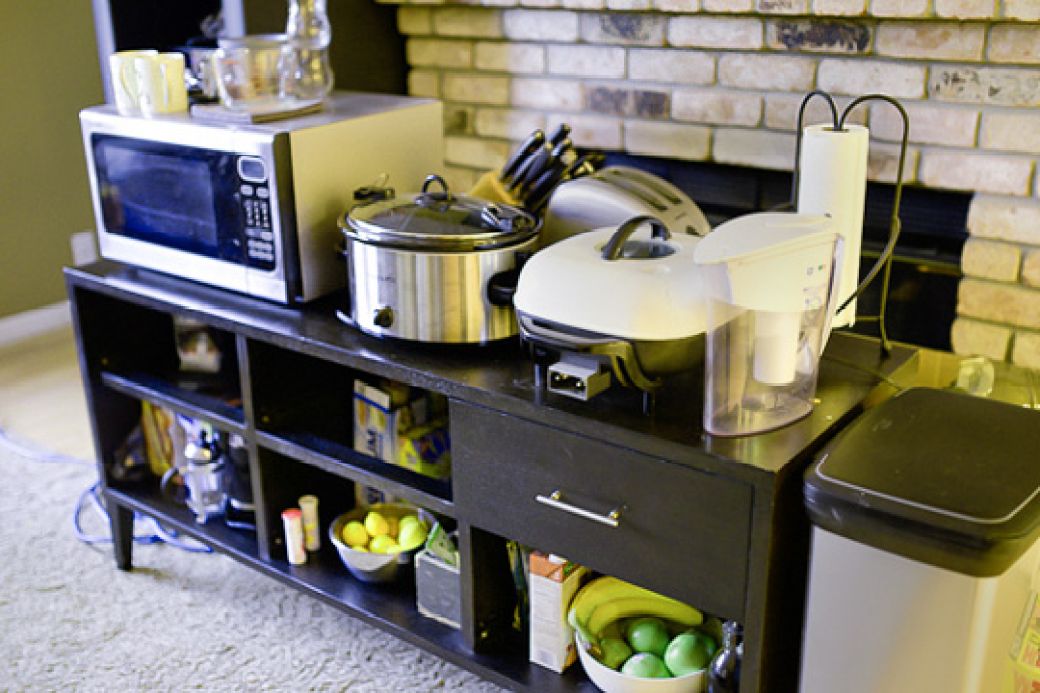Five months of bending over the bathtub to wash dishes during her kitchen remodel was no fun for homeowner and chef Christina Chavez. But the experience did teach her a few things that could benefit anyone who's doing a major remodel.
Here's her advice to keep the joy of cooking at home alive while your dream kitchen is under construction.
#1 Pick the Perfect Location
Like a perfect campsite, the spot for your temporary kitchen should be:
- In a low-traffic area
- As far from construction as possible
- Near a source of water
Places that may work include that barely used guest suite (especially if it has its own bathroom), the dining room, and even outdoors if you have a grill.
But think about electric outlets, Chavez warns, especially for a fridge. If you want to use your full-size fridge, make sure there's an outlet that can handle it. And you may have to give up your icemaker.
If you hope to use the garage, check with your contractor first. This space often ends up becoming a workshop and break room for your remodeling crew.
#2 Set Up a Water Source
If you don't have a inside your home, and you're remodeling during warmer months, you can set up a sink/wash area outside, which works nicely if you decide to use your grill a lot.
For less than $100, you can pick up a folding table outfitted with a faucet and sink that connects to your garden hose.
But wherever you locate your temporary wash area, keep a utility bin (like the kind you see in restaurants for bussing tables) handy to load up and lug dishes.
Here's a cool hack: Use a cooler with a drain plug. It can function as a utility bin and wash basin; use a hose outside or placing it in a tub or shower.
#3 Ask Your Contractor for Help
Check with your pro before you buy any supplies or break your back moving your refrigerator. Most contractors are happy to move and reconnect your fridge, and may be able to hook up a temporary utility sink for you to use in another room or outside.
Many remodelers also will loan clients amenities like a two-burner countertop stove, and some even include a temporary kitchen setup as part of their remodeling services.
Related: 5 Secrets Your Contractor Doesn't Want You to Know
#4 Make Temporary Countertops and Drawers
For countertops: A folding table or well-protected dining table functions just fine for prepping meals and holding small appliances that don't generate too much heat (think blender, microwave). With a little forethought, you can even relocate your existing countertop and cabinets after demolition begins, which is what Chavez did. But watch for rough spots that can damage your floor or give you a nasty splinter.
For drawers: Plastic storage bins or portable drawers on wheels that you can stash under the table, or a rolling cart with drawers provide a dust-free home for dishes, cooking utensils, ready-to-eat snacks, non-perishables, and basic cooking supplies.
Mallory Danks and her husband, who took on a three-month DIY kitchen remodel, made sure every cooking item had a place in rolling plastic drawers, making it easier to transition their living room back to its intended purpose after meals.
"You don't want to feel like you're living in your temporary kitchen," she says. Wheels make it easy to roll the clutter away.
#5 Stock It With Double-Duty Items
Without a full-size stove or oven, you'll have to MacGyver your meals, Danks says, and recommends thinking beyond your trusty microwave. Think multi-purpose (which will also make cleanup easier). For example:
- An electric kettle heats water for tea, oatmeal, soups, and even coffee if you use a French press (no need for a clunky coffee machine!).
- A newer electric pressure cooker does everything a range can — saute, roast, simmer, and warm. It also works as a slow cooker.
- A blender does both smoothies and sauces.
- An electric skillet makes everything from pancakes to pot roast.
- Microwave-safe dishes to store, reheat, and serve.
- Long-handled tongs flip burgers and serve salads.
- A glass measuring cup to also heat water in the microwave or scoop up sauces and soups.
The key is to be able to do the most common cooking tasks that make meal preparation easy for you (and to do that without over-packing your makeshift cooking zone). Otherwise, you might feel overwhelmed.
But if the idea of living without your pour-over coffeemaker makes you cry a little inside, then include it. Life is going to be disruptive enough without giving up the little joys.
#6 Protect Furnishings
There's a reason wall-to-wall carpeting isn't standard kitchen fare. Cooking and cleanup are hard on flooring and furnishings, so relocate or cover anything of value in your temporary kitchen, recommends Chavez.
"I learned the hard way that you should cover your dining room table," she says, recalling a hot pot that left a mark.
Don't forget to remove area rugs to keep them free of stains and make cleanup a little easier. Or, use an older rug that you plan to replace after the remodel.
#7 Make Cleanup Easy (Without Hurting the Earth)
Stock a minimal supply of dining and cooking supplies. Allot each family member just two plates, bowls, cups, drinking glasses, and sets of utensils. That way, doing the dishes becomes a necessity after a meal or two, and there's never too many dishes to be daunting.
But, still, there's something to be said for using disposable gear when you're living sans-dishwasher. For those times, buy disposable plates and utensils that are biodegradable, made from sustainable materials, or even compostable. Plus you'll be using a whole lot less water.
Let the adventure begin!
